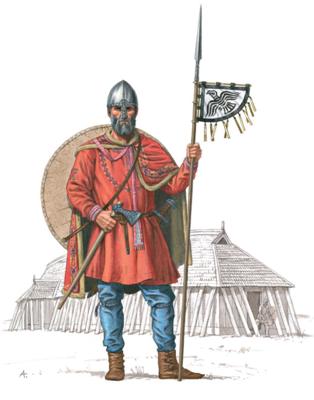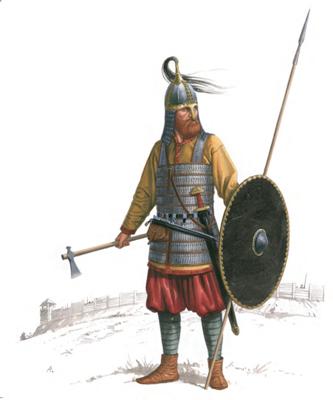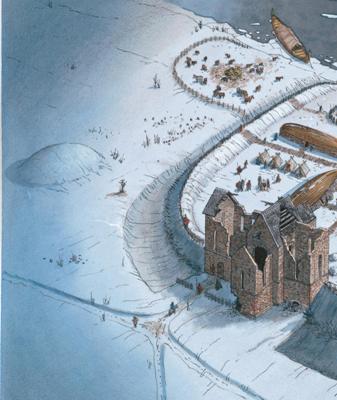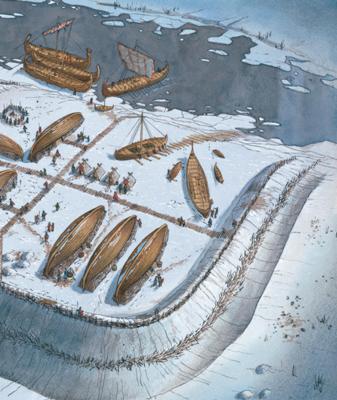 Pirates and Privateers Pirates and Privateers
The History of Maritime
Piracy
Cindy Vallar, Editor
& Reviewer
P.O. Box 425,
Keller, TX 76244-0425
    
Books for
Adults ~ History

Vikings at War
by Kim Hjardar and Vegard Vike
Casemate, 2016, ISBN 978-1-61200-403-7, US $39.95 / UK
£29.95
    
Fighting
and war were intricately woven in the tapestry of
Viking life. It was brutal and raw, just like life
itself, and Vikings were particularly good at
mastering the components that constituted this
lifestyle. Rather than examine the entire sphere of
the Viking world from AD 750 to 1100, the authors
focus on one facet of this society – the warriors,
whose activities impacted the lives of many from
America in the west, to the Caspian Sea in the east,
from the Russian forests of the north, to Jerusalem
to the south. Their intrusive raids ultimately led
to upheavals that altered the course of European
history.
Hjardar and Vike present this comprehensive
examination in six chapters, each focusing on a
particular aspect of a warrior’s life. It begins
with the inside covers, which are full-color maps
depicting the Viking world during a period of 350
years. Many histories of this era open with an
account of the raid on the Lindisfarne Priory on
Holy Island or Iona Abbey in the Hebrides; these
authors choose an even earlier incursion when King
Beorhtric of Wessex sends his bailiff to confront
the intruders into his realm in the summer of AD
789. This first record of a violent encounter at the
hands of the Vikings does not end well for the
bailiff.
Whether they were called Norsemen, Danes, heathens,
Rus, Varangians, al-madjus, Finn Gall,
or Dubh Gall, they had two things in common.
They came from North, the region we know as
Scandinavia, and they were Vikings. Chapter one
answers five basic questions: who they were; what
“Viking” meant (both then and later); why the raids
began; what technological advancements allowed them
to venture far from land; and how Vikings, rather
than Christians, saw the world. This section also
examines Viking society and the role of the warrior
in it, as well as their religion.
No book on warriors and military life would be
complete without a discussion on “The Art of War,”
which is the topic discussed in chapter two. This
umbrella covers many facets: troops, homeland
defense, trial by combat, training, raiding, battle
formations, intelligence and logistics, strategy and
stratagems, mercenaries, beserkers and wolfskins,
warrior women, and tending the sick and wounded.
Chapter three looks at fortifications, both
temporary and permanent, while chapter four focuses
on Viking ships. The latter includes a double-page
timeline that shows how the cargoes, barges, and
longships developed. There is also an annotated list
of archeological finds of these vessels.
Chapter five, the only one written by Vegard Vike,
focuses on Viking weaponry. All freemen were
expected to have and use three types of weapons to
defend the land. Weapons were status symbols in both
life and death. The principal arms were the spear,
shield, and sword or axe, but also discussed are
knives, bows and arrows, and personal armor. The
arms trade is another topic Vike covers.
The final chapter, the longest of the six, centers
on Viking invasions. Here Hjardar divides up the
world into eight parts: Islands in the West,
Ireland, England, the Frankish Empire and France,
the Iberian peninsula, lands in the East, Byzantium,
and Greenland and America. Each part includes a
full-page color image of the Viking who invades that
region. This allows readers to see the similarities
and differences, for example, between a Viking who
goes to Ireland and one who travels as far as
America. In addition to explaining how the invaders
reach these destinations, Hjardar provides overviews
of the raids and battles that occurd there and how
that area’s Viking history unfolds. Readers are also
introduced to specific Vikings whose names – such as
the Earls of Orkney, Sigtrygg Silkbeard, Eirik
Bloodaxe, Olav Tryggvason, Svjatoslav, and the
Varangian Guard – and experiences are recounted in
the historical record.
 
Left: Warrior in Gudrod's army
around 800, who may have fought the Franks.
Right: Garrison soldier from Birka around 930.
Equipment displays Eastern characteristics.
(Both images are
copyrighted and used with permission of
publisher.)
A host of color photographs, diagrams, maps and
battle movements, and artwork beautifully illustrate
this 400-page coffee-table-sized book. Several
double-page spreads of original artwork allow
readers to visualize such things as a ship burial,
the raid on Lindisfarne, and the Vikings’ winter
camp in Repton, England. Throughout the text, the
authors include excerpts from original sources to
enrich and enhance the topic being discussed.
Special boxed highlights, incorporated into every
chapter, showcase such subjects as early warrior
culture, a woman’s honor, loyalty oaths, traveling
to the afterlife, and persons of particular renown.
Aside from the endnotes, there are a bibliography
and an index with four separate divisions – people,
places, subjects, and major battles. A list of maps
is also included.
 
Example of original artwork
depicting what the winter camp in Repton,
England may have looked like in 873-874.
(Both images are
copyrighted and used with permission of
publisher.)
The only section with outdated information appears
in chapter two and concerns warrior women. This
isn’t the author’s fault, as results of DNA studies
on a Viking warrior found in 1888 have only recently
been shared publicly. Viking warrior women did exist
outside of folklore; to the author’s credit, he did
leave open the possibility that some women, and even
men, stepped outside their sex’s normal societal
constraints to follow a different path.
The authors’ purpose in writing this book is to
provide readers with a vivid look into the Viking
Age, and this they consummately achieve. Even though
the writing isn’t always riveting, nuanced insights
and delightful historical tidbits make this volume
not only a worthy addition to any collection
specializing in Scandinavian history, but also a
stellar resource for history buffs and authors
seeking background for their novels.
Review
Copyright ©2018 Cindy Vallar

Click to contact me
Background image compliments
of Anke's Graphics |





